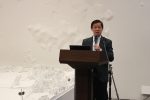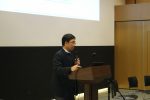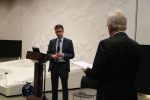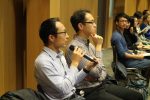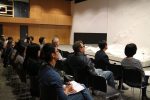Date/Time
Date(s): 25/11/2016
Time: 6:30 pm - 8:30 pm
- Category A: Introduction of the city/region for a general audience (students and others) with an emphasis on current urban innovation activities
- Category B: Seminar/Talk with a city-specific focus on current urban innovation projects for an interested academic audience & special-interest groups
- Vienna
Location
City Gallery, Central
Language: English
Admission: Free
Event Partner(s): (see "collaborators")
Speaker(s):
- Mr. Roland Sommer, CEO, Plattform Industrie 4.0, Vienna (click here to download the presentation)
- Ir. Raymond Fong, General Manager of Environmental Management Division, Hong Kong Productivity Council (click here to download the presentation)
- Dr. Frank Tong, Research & Technology Development Director, R&D Centre for Logistics & Supply Chain Management (click here to download the presentation)
- Prof. H. Werner Hess (Introduction/Moderator)
The dialogue was a continuation of the discussion about the role of innovation in urban development, in particular, how societies respond to technological developments. How can cities prepare for them? How will the ‘industrial revolution 4.0’ influence people’s lives in smart cities of the future? ‘Industry 4.0’ is about to fuse industrial production and digital systems, a process that requires far-reaching socio-technical innovations, new business models and regulatory frameworks, infrastructure investments, as well as the revision of social systems, labor markets, education and human resource management. Profound social changes will occur.
The main topic was the ‘Internet of Everything’ (comprising the Internet of People, the Internet of Things and the Internet of Services) and its application in Vienna and Hong Kong, in smart energy management and logistics, among others.
Vienna __________________________________________________________________
Mr. Roland Sommer explained that the ubiquitous use of sensors and limitless digitalization are two main trends affecting cities of the future. Sensors can be used for home automation control, smart household appliances (e.g. smart fridge, smart stove), smart watches, heartbeat and blood pressure control (with the possibility of real time transfer to doctors), robots for cleaning tasks, robots taking care of patients, etc. The digitalization, which underpins Industry 4.0, affects entire supply chains. It requires system thinking and knowledge automation for structuring and analyzing large amounts of generated data and lead to new business models, primarily based on services rather than the sale of manufactured products. Machines are connected by cloud technology, with large data volumes easily stored. Production takes place in a collaborative environment between robots and humans. There is a huge potential in additive manufacturing and 3D printing. In Industry 4.0, the interplay between research, industry and services can work as a comparative advantage to cities. The Internet of Things (IoT), the Internet of People (IoP) and the Internet of Services (IoS) are merging into a wholly data-driven Internet of Everything (IoE). Among industries, the media are already fully digitalized, followed by partially digitalization in retail and banking. Other sectors are not yet ‘disrupted’ by the IoE to a similar extent. However, digitalization will lead to more flexible production, as many types and models of products can be manufactured on one assembly line. Production will be digitally simulated first so as to choose the best ‘real’ setup. Due to changes in required qualifications, everyone on production sites will become a ‘decision maker’. Moreover, digital technologies will vastly improve inter-company communications.
Like all EU countries, Austria intends to expand manufacturing again. However, this requires new business models ensuring higher productivity by shifting from hardware to software, from simply selling products to selling long-term services and creating digital platforms for them. In the urban context, data collected through sensors has to be structured first and then combined to provide more information. For instance, rainfall data can be linked with data about traffic or landslides and monitor those indicators in real-time. Mr. Sommer provided an example of the use of data in Rio de Janeiro during the Olympic Games, where a newly-created data center monitored trash collection, electricity, water, emergency situations, disease outbreak, and other factors. In the case of heavy traffic, waste collection trucks could adjust their routes accordingly. Intelligent parking systems facilitating the search for parking spaces in the neighborhood, intelligent sensors analyzing face emotions on streets and adjusting lighting systems are other examples of possible smart city solutions.
In Vienna, new districts like ‘Seestadt aspern’ are designed as multi-functional areas combining housing, workplaces, production sites and leisure facilities. City planners move away from the functional separation of urban space. At the same time, they pave the way for digitalization and subsequently bring back production into the city. Seestadt aspern is also testing site, as it contains a pilot factory for Industry 4.0. Universities manage similar facilities. It is expected that they help create acceptance for small-scale production in the neighborhood, which is increasingly ‘green’ and produces little noise and emissions. New technologies will help facilitate urban logistics, as effective traffic management systems are being developed. Cities need to become carbon-neutral, not least by using renewable energy sources and placing and photovoltaic systems in and on buildings. The ensuing energy grids of decentralized energy production systems will require extensive IoE management expertise.
In terms of manufacturing, environmentally neutral production (e.g. by 3D printing) can be stacked vertically and indeed combined with office and housing space in one building, a solution for densely populated cities like Hong Kong. To revive industrial production, cities will have to designate new urban manufacturing zones. This has already been done in Europe, for example in Barcelona’s new district 22@, which reserves 20% of all built-up space for industrial purposes. Mr. Sommer argued that bringing manufacturing back to city locations requires new zoning regulations and a lowering of inner-city rents. In the case of converting brownfield sites, intensive communication with neighboring citizens is required, ideally with a long-term caretaker of conversion projects on site. He explained that such a new approach to the redevelopment of old industrial areas is currently being tested in the city of Graz in Austria. Public transport has been introduced first. The set-up of a decentralized energy production system in the district followed, while space for future production and commercial facilities was reserved. All along, the city has been organizing meetings, activities, markets and social gatherings to learn about people’s expectations and create a future-oriented community spirit.
In the Q&A discussion Mr. Sommer elaborated details about urban smart grids and energy consumption recording via smart metering. Based on big data analysis, new software can predict how much energy will be used at any given time. Batteries can save unused energy until the moment it is needed. Wind is also measured to predict the need for heating. With regard to smart waste management, bins in Graz are now being equipped with sensors that report electronically when a bin is full. The data can be further combined with calculations to created optimal waste collection routes. As regards IoE and IoT development, he admitted that it can be a challenge to persuade companies to adopt new technologies. It has to be done in a step by step process of information and demonstration. But eventually, companies will have to accept that they require new ‘disruptive’ business models if they want to survive.
Mr. Sommer further explained that city projects are now normally based on risk-sharing public-private partnerships, with investment from both the city government and private investors. A ‘give-and-take approach’ is also preferred if, for instance, land is allocated to build housing. As a matter of routine, the city government demands part of the revenue to be reinvested in building and further improving environmentally sustainable public infrastructure that also allows future industrial usage.
Another topic discussed was health data collection and the use of robots in elderly care. Mr. Sommer said that social security systems need to implement cost-cutting measures. At the same time, they intend to improve services with new IoE tools. That can include robots do heavy manual work in the health sector so that caretakers would have more time for other tasks and possibly have closer relations with patients. However, health-related data has to remain private. Already today, European Union law plays an important role in strictly regulating data handling. Violations of these regulations lead to high fines.
Hong Kong _______________________________________________________________
Mr. Raymond Fong concentrated on the improvement of productivity and resource management through smart energy management, based on experiences of the Hong Kong Productivity Council (HKPC). The HKPC provided assistance to factory owners for increasing the energy efficiency of production facilities located across the border. He explained that the first step is an energy audit, then research and information analysis, which leads to the design of an online energy management system that can be monitored remotely. In local smart homes, smart meters can be installed to track energy patterns and even analyze residents’ habits (e.g. viewing TV). The energy analysis then provides data on the operation mode of all appliances on the premises, therefore the basis for efficiency improvement measures.
The HKPC offers data analysis services to Hong Kong-owned factories in Guangdong Province. In each factory, a system of around 100 meters has to be installed. The energy data is accessible through the cloud. Factories in China opt for such systems because they are now pressured by national environmental regulations to lower their energy consumption. In addition, foreign buyers of products now increasingly impose their own requirements and force factories to lower production costs. The data acquired can show the share of energy consumed per factory department or individual machine used so as to help in future money allocation plans. Through an energy consumption trend analysis, a factory can check whether there are any problems or outright system failures (e.g. when production machines consume less energy than their peripheral equipment). In one of the cases presented by Mr. Fong, leakage of compressed air was found even on no-production days; compressor activity was detected. Such abnormalities were also revealed when machines produced energy during lunchtime, at night or on holidays when they should be turned off. Comparing normal machine operation patterns with actual operation data helps spot irregularities and thus facilitates equipment maintenance. In one of the factories the central chiller plant was on and seemed to work properly but abnormal power consumption indicated malfunctioning, which would otherwise go unnoticed. Energy consumption analysis is also useful for developing energy performance indicators and benchmarking for comparing different machines. Differences in energy consumption for the same equipment during day and night shifts may lead to significant findings, For example, when one work shift consumes far more energy than the other, this may indicate that the employees do not run machines properly or need more training. Moreover, a comparison between energy spent on the production of different products allows for precise ‘energy accounting’ and therefore energy-sensitive pricing of the production of specific items. Mr. Fong presented an automated diagnosis of printing machines, which provided an energy-based analysis of the performance of each. This allowed comparisons between them along parameters such as unplanned paper refills, calibration time, and the printing/calibration ratio. In this way, it could be determined which machines were least efficient and their operation could be improved accordingly. Factories benefit from installing such systems because they raise an operator’s awareness, can increase productivity and ensure proper machine maintenance. It works best when factories employ a dedicated energy manager or consultant to design and set up the energy management system and help with data analysis.
Commenting on the presentation, Mr. Sommer said that in addition to energy meters, smart sensors can be installed to provide information on various indicators and control the quality at every step of production. Mr. Fong explained that existing Building Management Systems suppliers in Hong Kong can add energy meters in new commercial buildings. Although this is not yet very common, there is an ongoing discussion that new smart buildings will have to be equipped with such energy management systems. There are legal regulations that require the owners of premises to install energy meters in critical building services, for example in monitoring the system performance of chillers, lifts or escalators.
Mr. Frank Tong presented more projects of the LSCM Hong Kong R&D Centre. The center was established by the Hong Kong Government so as to maintain the competitiveness and excellence of the local logistics sector via the extensive use of IT technologies and enhance technology transfer from research to industry. Smart logistics innovations are being introduced in cross-boundary customs clearance for goods shipped internationally, in e-commerce and warehousing, the networks of ‘last mile delivery’, and in GNSS global tracking and product safety. All these measures streamline local logistics processes, especially in times when global competition is fierce and new opportunities open up in the wake of the One Belt One Road Initiative of the Chinese government. The LSCM has tested solutions based on RFID (radio-frequency identification and tracking systems, using tags attached to objects), the Internet of Things (sensors), location computing (GPS), and robotics. Hong Kong Customs has benefited from installing electronic locks on cargo trucks transiting through Hong Kong. Only a roadside radio controller could open such locks, whenever a truck crosses the Hong Kong border. This makes it easier for customs officers at air-cargo facilities and saves over 2 hours of handling and transport time. It also allows the route monitoring of the cargo and thereby prevent any illegal activities. Moreover, RFID scanning devices installed on the Tsing Ma Bridge provide pre-arrival notification to air-cargo terminals, which helps increase the efficiency of loading and unloading procedures. Hong Kong and China customs are trying to establish closer cooperation in these fields. There are currently 12 ITFS checkpoints in Hong Kong and 22 in China which allow electronic customs clearance without actually stopping the cargo trucks.
Another LSCM project currently tests the automation of cargo lifting and moving in warehouse operations. The project is inspired by solutions used in Amazon warehouses, but there is a lot of potential in replicating these ideas in Hong Kong. Mr. Tong explained that businesses welcome such ideas because they want to reduce energy and land cost and make warehouses as compact as possible, with little walking space between shelves. Automated devices can move shelves or pick particular products, put them into boxes and take them out. Sensors are useful to monitor the environment in places which have to maintain good ventilation and humidity levels, for example film archives and museums. They can also measure and automatically monitor temperature conditions in cold storage warehouses at various locations of a room. At air-cargo terminals, where cargos have to be taken out and transported to the airfield, the carts are now equipped with RFID. Operated from a console, staff can now type in a particular flight number. A signal is then sent to the carts, which turn on a light. The easy visibility to the staff improves efficiency of the loading process. Management can also see on computer screens where carts are located.
Mr. Tong said that logistics are an important element in building public housing in Hong Kong because prefabricated parts are shipped in from China. New technologies are deployed in this sector as well. Since land is so expensive that facades cannot be stored at warehouses in Hong Kong, the parts are shipped in only when they are needed. Each piece now has RFID so they can be tracked when they come to Hong Kong.
Logistics in Hong Kong also need to be adapted to e-commerce. LSCM therefore has worked with the Hong Kong Post in deploying smart lockers first at post offices and then at shopping malls and MTR stations. Thus, it will not be necessary to be at home at the time of delivery. Customers are able to pick up parcels close to their homes. An SMS will inform them when a parcel is ready for collection and information will be sent to the seller once it is received. Hong Kong enjoys a very high GPS accuracy, which can be used for various location-based services. Further improvements are expected once the Chinese BeiDou Navigation Satellite System becomes fully operable. Finally, if in the future all parcels will carry RFID, one will be able to trace them to an original manufacturer and thereby also help prevent counterfeiting.
Discussion _______________________________________________________________
The speakers discussed risks related to massive data collection via sensors and tracking technologies, for example if government demands its release and wants to exercise more control over them. Mr. Tong clarified that the government in Hong Kong cannot force private operators to open up their data because the Privacy Commissioner for Personal Data monitors whether personal privacy rights have been adhered to. For example, there are concerns over technologies such as RFID, which could easily become personal IDs instead of product IDs when placed on garments of personnel. Mr. Sommer said that the big question in Europe is who owns the data transmitted by ‘things’, whether it should belong to the rightful product owner, the manufacturer or the infrastructure provider. There are regulations for private companies but in sectors such as healthcare, the handling of patients’ data is not yet fully regulated.
Regarding new trends in mobility, interest in electric and electronically fully equipped cars in Hong Kong is still very small and TESLA currently dominates the market. There is also a lack of projects testing the operation of autonomous vehicles in controlled areas. However, more will be done in automated logistics to experiment with the use of robots for parcel delivery, food and medication in small districts, but only in confined areas at first. Mr. Sommer argued that in Europe autonomous driving is likely to expand first in the agricultural sector, although at the cost of many low-wage jobs. At the same time new jobs will be created which require knowledge in data analytics, intelligence and logistics algorithms. There will also be problems with retraining drivers of agricultural machinery and vehicles. Mr. Tong talked about possibilities to extend RFID technology to food imports from China. So far, as he explained, it has not been used due to safety concerns. Moreover, food controls tend to be very strict. More cooperation with food safety departments in China would be needed.
Mr. Sommer concluded that Vienna and Hong Kong face similar challenges and there is a great potential for cooperation between the cities. Vienna shares the same goal of re-industrialization in the urban environment, and yet there are areas for improvement such as knowledge transfer. There are many aspects upon which the two cities could build trustful cooperation and thereby learn from each other.
Background Information ___________________________________________________
Association Industry 4.0 Austria – Plattform Industrie 4.0 Österreich (German only): http://plattformindustrie40.at/
Hong Kong Productivity Council: https://www.hkpc.org/en/
LSCM R&D Centre: http://www.lscm.hk/eng/
Photos:

ENQUIRIES
Bookings
Bookings are closed for this event.

![[SEMINAR] Hong Kong - Vienna Dialogue: Smart City Life and the 'Internet of Everything'](http://euap.hkbu.edu.hk/series/wp-content/uploads/2016/10/IMG_7724.jpg)
